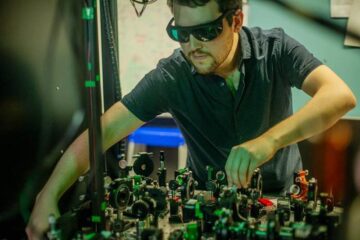Plasma as a fast optical switch

Just like an electrical switch allows the flow of electricity into electrical circuits, relativistic transparency in plasma can act like a fast optical switch allowing the flow of light through otherwise opaque plasma.
Modern day lasers, such as the Trident laser in Los Alamos National Laboratory delivers a 200 terawatt power pulse (roughly 400 times the average electrical consumption of the United States) in half a trillionth of a second (picosecond) time. As shown in Fig. 1, when the laser power reaches a threshold limit, relativistic transparency in plasma turns the initially opaque plasma transparent in less than a tenth of a picosecond.
Powerful lasers are used to drive plasmas in next-generation particle accelerators and x-ray beams. One shortcoming of these beams is that they typically have a range of energy, caused by the gradual rise of laser power from zero to its maximum level. Using an optical switch, this ramp up time can be reduced to less than a tenth of a picosecond, delivering peak laser power to the plasma on a faster time scale.
So, how does this relativistic transparency happen inside plasma? When a laser beam is incident on (or strikes) plasma, electrons in the plasma react to the laser to cancel its presence inside the plasma. But when the laser is powerful enough to accelerate electrons close to the speed of light, the mass of the electrons increases, making them “heavier.” These heavier electrons cannot react quickly enough; hence the laser beam propagates through the plasma.
Now, for the first time, scientists at Los Alamos National Laboratory and Ludwig-Maximilian Universität (LMU) in Germany have been able to make a direct observation of relativistic transparency in thin plasmas using a Frequency-Resolved Optical Gating (FROG) device. The discovery was made possible by two key capabilities: the ability to fabricate carbon foils a few nanometers thick to produce thin plasma, and the elimination of optical noise preceding the Trident laser pulse on a few picosecond timescale.
Initially, the researchers observed pulse shortening due to relativistic transparency and consistent spectral broadening. Later, they also measured the shape of the laser pulses incident on and transmitted through the plasma to directly observe the transparency as shown in figure 2. The transmitted laser pulse is roughly half the duration of the incident laser pulse, with a transparency turn on time around a fifth of a picosecond. The experimental results are well consistent with that of computer simulation, except the loss of fast turn-on time due to propagation effects arising from diffraction. Efforts are currently underway to eliminate diffraction limitations to observe the true turn-on time.
Media Contact
More Information:
http://www.utexas.eduAll latest news from the category: Physics and Astronomy
This area deals with the fundamental laws and building blocks of nature and how they interact, the properties and the behavior of matter, and research into space and time and their structures.
innovations-report provides in-depth reports and articles on subjects such as astrophysics, laser technologies, nuclear, quantum, particle and solid-state physics, nanotechnologies, planetary research and findings (Mars, Venus) and developments related to the Hubble Telescope.
Newest articles

Combatting disruptive ‘noise’ in quantum communication
In a significant milestone for quantum communication technology, an experiment has demonstrated how networks can be leveraged to combat disruptive ‘noise’ in quantum communications. The international effort led by researchers…

Stretchable quantum dot display
Intrinsically stretchable quantum dot-based light-emitting diodes achieved record-breaking performance. A team of South Korean scientists led by Professor KIM Dae-Hyeong of the Center for Nanoparticle Research within the Institute for…

Internet can achieve quantum speed with light saved as sound
Researchers at the University of Copenhagen’s Niels Bohr Institute have developed a new way to create quantum memory: A small drum can store data sent with light in its sonic…





















